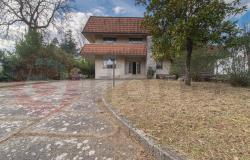Seems a real shame to have
Submitted by qui già on Sat, 05/21/2011 - 03:05In reply to A newbie all over again! by Annec
Would that be before or after
Submitted by Annec on Sat, 05/21/2011 - 16:10In reply to Seems a real shame to have by qui già
Yes, regarding the
Submitted by Winnifred on Fri, 05/27/2011 - 10:45In reply to Seems a real shame to have by qui già
Yes, regarding the underpinning of the house, we agree that it would have been best to try to keep the house but we were advised that it was better this way, some of our walls were in a very precarious position and the comune also allowed us an extra 20% of footprint. We have at least retained the stables which will give me my dream kitchen with pillars and vaulted ceilings. Thanks to everyone for your answers and we are seeking out the books and will get in touch with the professor when we are back in Italy next month. We appreciate everyone's comments. Thanks
I would suggest you contact
Submitted by Angie and Robert on Sat, 05/21/2011 - 04:42In reply to A newbie all over again! by Annec
I would suggest you contact prof. Giuseppe Milozzi, an expert in the Marche region, but whom I am sure would also have information on Emilia Romagna. email: info@casadellamemoria.org.......Giuseppe speaks fluent English, hope this helps.
Mention the War
Submitted by SirTK on Sat, 05/21/2011 - 10:15In reply to A newbie all over again! by Annec
I recently read "Italy's Sorrow" by James Holland which gives a (fairly harrowing) account of Italy's plight after the armistice, when Axis armies were forced northwards out of Italy by the Allies, both sides laying waste to vast tracts of the country and killing thousands of people on the way. The only mention of Emilia Romagna is about the slaughter of "more than 30 men, women and children at the tiny village of Bettola" but I thoroughly recommend the book to give some idea of what the Italian people went through. Terry (As a footnote, there is an official plaque on my garage wall designating the very spot where partisans blocked the road with a tree trunk and apprehended the disguised Mussolini and Clara Petacci in their attempt to escape to Switzerland. Our village is currently building a museum to commemorate the event).
This link may give you some
Submitted by Andiamo on Sat, 05/21/2011 - 12:46In reply to A newbie all over again! by Annec
This link may give you some idea as to what went on in the area. http://www.riccione.net/more/seconda_guerra_mondiale_in_emilia_romagna.htm
I second Terry's
Submitted by Annec on Sat, 05/21/2011 - 16:09In reply to A newbie all over again! by Annec
I second Terry's recommendation of "Italy's Sorrow". Harrowing reading though, since it is mostly personal testimony of a bloody carnage that has always unfairly played second fiddle to D-Day. Not your region, but there is a lot of information about PoWs camps in Marche here: http://camp59survivors.wordpress.com/
'Love and war in the
Submitted by qui già on Sun, 05/22/2011 - 03:29In reply to A newbie all over again! by Annec
'Love and war in the Appennines' by Eric Newby In this book he mentions looking out of his window and seeing a very large square rock- It's called 'Bismantova' near Castelnovo ne monti. I think it's probably about 1 hour from where your house is, also quite a lot of activity in and around 'Minozzo' near the town on 'Villa Minozzo' There is a library in the square in Villa, which may have info or you could ask in the comune.
Grenades and partisans
Submitted by KarenSheffield on Fri, 05/27/2011 - 12:34In reply to A newbie all over again! by Annec
Sorry to hear that your house had to be demolished because of the grenades. Have you found out whether they were Axis or Allied grenades? I know that at the end of the war there was a general settling of scores. A friend at the University of Bologna told me that her elderly neighbour had been a resistance fighter, and after the war he had personally shot local Fascists. Mussolini was not the only one executed. Bologna has always been a strongly Communist area, so Fascists could expect little quarter after the defeat by the Allies.
Got any pictures
Submitted by Centauro on Fri, 05/27/2011 - 16:07In reply to A newbie all over again! by Annec
Got any pictures Winnifred? Do your unwanted guests look anthing like these? (From L-R) British No36 Mills Bomb. US Mk.IIA1 'Pineapple'. German M24 'Potato Masher'. Italian SCRM 'Red Devil'. Some of the more numerous grenades used in the ETO during WWII. 


 Hope this helps you to identify your relics. Also a new Resistance/Partisan (http://www.resistenzapiacenza.it/) museum opened a couple of years ago in the Val' D'Arda, not a million miles from you, they might be able to help with your enquiries. Saluti.
Hope this helps you to identify your relics. Also a new Resistance/Partisan (http://www.resistenzapiacenza.it/) museum opened a couple of years ago in the Val' D'Arda, not a million miles from you, they might be able to help with your enquiries. Saluti.
Hand Grenades on site
Submitted by Winnifred on Fri, 05/27/2011 - 19:32In reply to Got any pictures by Centauro
Thank Centauro If you have a look at our website www.ozinitaly.com and photos of the demolition you will see the grenades - looks more like the US one but a little different. We are still waiting for the bomb disposal people as they now need to check the site to see if there are any more little 'surprises'. The website you mentioned also looks interesting.
Bombs Away!!!
Submitted by Centauro on Sat, 05/28/2011 - 12:23In reply to Hand Grenades on site by Winnifred
Very interesting Winnifred. What you have there would, on closer inspection (and without actually getting my hands on one) appear to be four No5 MkII British Mills Bombs. What is particularly curious about them is that this version of the Mills Bomb is of WWI vintage and was declared obsolete in 1918, so by my reckoning they are at least 93 years old. British forces were deployed in Italy during the 1914-18 War and so it is possible that some light fingered Luigi decided to hang on to a few just in case.... Either that, or as is more likely a number of empty grenade casings were taken from storage in the UK, refurbished and dropped by parachute to supply the local partisans during WWII. In the photograph below taken sometime after 1942, you can see some of the Val D'Arda partisans, two of whom are armed with the same version of the Mills grenade that you have uncovered on your property, along with a few other toys of course........ Ps. The chap on the left is a relative of mine and the rifle being held by the fellow (we're pretty sure it's the same one) on the right is still in my cousin's family's possession. Back in the 1960's I remember the Army came to our village and cleared everyone out for a few days while they dealt with the remains of the Partisans' weapon supplies. Apparently they had stored a load of weapons, ammunition and demolition explosives in a gap between the walls of a barn and a house. It remained there for more than 20 years, forgotten about until they had to repair the roof of the barn when one of the villagers looked down and got the fright of his life.... My grandfather once told me that the Army filled two trucks with the stores that they had to remove. Saluti.
Bombs Away!
Submitted by Winnifred on Sun, 05/29/2011 - 05:47In reply to Bombs Away!!! by Centauro
Hi Centauro Thanks for all your information. We arrived to a similar conclusion over dinner last night and probably a few too many reds. We scoured the web and finally found photos of the British Mills bombs only that our 'expert' friend believed that one is a 36M and the other 3 are No.5 Mills bombs. I can't remember which, but he also maintained that one type could be screwed to a rifle and launched in that manner. It is all quite fascinating and I enjoyed reading about your personal stories in the village. I have also contacted our sindico who is very helpful to ask him about the history of the area at that time. Sadly I couldn't get your photo to open. Will let you know when and if we hear more - we are currently still in Australia and will get to Polinago in late June. Hopefully it will all be settled and work can continue on the house!
(No subject)
Submitted by Centauro on Sun, 05/29/2011 - 08:20In reply to A newbie all over again! by Annec
Fixed it (I think)!
Submitted by Centauro on Sun, 05/29/2011 - 08:21In reply to A newbie all over again! by Annec
Great Photo
Submitted by Winnifred on Mon, 05/30/2011 - 04:02In reply to Fixed it (I think)! by Centauro
Emilia Romagna, the northern…
Submitted by verazvezdda on Sun, 01/29/2023 - 14:35Emilia Romagna, the northern Italian region between the Po River and the Adriatic Sea, is home to a unique and fascinating history of World War II. This region was the primary site of numerous battles and operations during the war, and is a must-see destination for anyone interested in the history of WWII. Here, visitors can explore the ruins of war-ravaged cities and battlefields, as well as explore the fascinating history of the Italian resistance movement. Lots of interesting topics can be found on this site mytimeinhistory.com
A tour of WWII history in Emilia Romagna can start in the city of Bologna, where the Italian resistance movement was first formed. The area was also the site of numerous battles and operations, including the Battle of Bologna, which saw the Germans retreat from the city after an evacuation order. Visitors can also explore nearby Forte di San Leo, a fortress that was an important German stronghold during the war. Further to the east, tourists can visit the city of Faenza, where the final battle of WWII took place. Here, visitors can explore the ruins of the battle and learn more about the history of the conflict.















